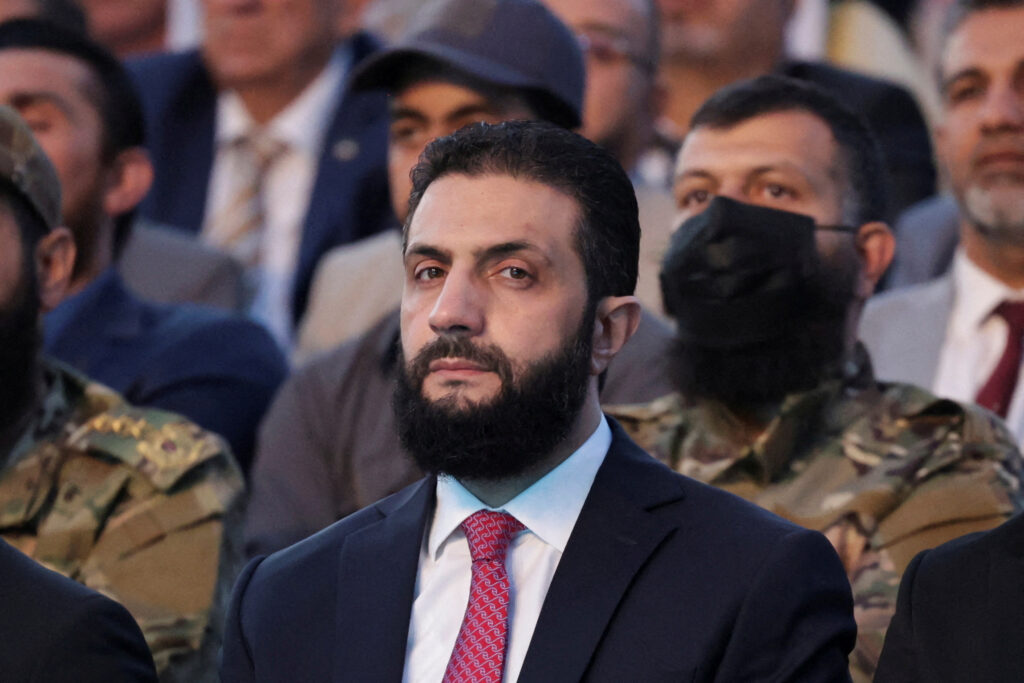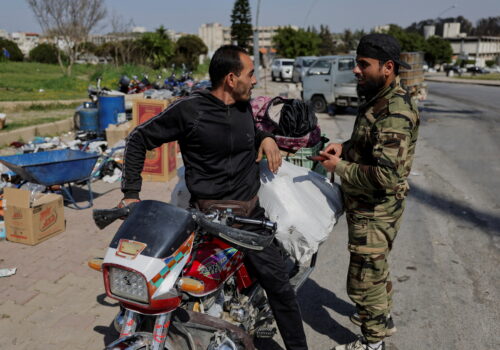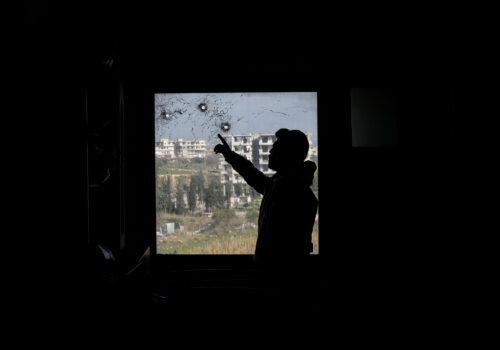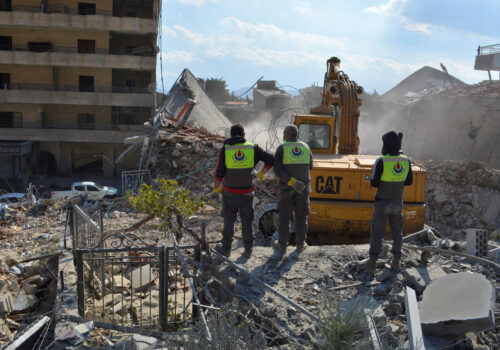Israel’s approach to Syria since the fall of Bashar al-Assad’s regime has become more assertive, driven by security fears that were intensified by the trauma of the October 7, 2023 Hamas attacks. For Jerusalem, the emergence of the interim President Ahmed al-Sharaa’s transitional government is a double-edged sword that could serve as an opportunity for strategic realignment, but also poses latent threats.
Although al-Sharaa’s rise has rightfully generated considerable concern given his jihadist background, the new Syrian government’s first six months has had notable positive developments. This includes the presentation of a pragmatic agenda that has emphasized power-sharing, minority rights, and economic development.
Further bolstering his international standing, al-Sharaa secured broad sanctions relief from the United States after a meeting with President Donald Trump in Saudi Arabia.
The US president’s recent executive order lifting Syria sanctions, signed on June 30, states that “the United States is committed to supporting a Syria that is stable, unified, and at peace with itself and its neighbors.” al-Sharaa also assuaged fears about potential nuclear activity after he offered full cooperation and access to the United Nations International Atomic Energy Agency after a visit by the agency’s Director General Rafael Grossi in early June.
Although al-Sharaa has made several moves that should reassure Israeli decision makers: refraining from engaging with Hamas, expelling factions of the Popular Front for the Liberation of Palestine and Hamas, arresting two senior Palestinian Islamic Jihad figures, and trying to thwart smuggling operations between Iran and Hezbollah across Syria—they appear unconvinced.
Instead of seeing the efforts as transformational, Israel is skeptical that al-Sharaa will be able to maintain control over the country, fulfilling the Israeli desire to prevent another security vacuum and preserve its operational freedom to neutralize potential threats.
But it is in this vein that, while keeping an eye on developments, there is a clear Israeli interest that al-Sharaa succeed. Israel will be wise to align its policy with those who seek to integrate Syria, rather than with those who seek to fragment it.
Fault lines beneath the surface
In early March, heavy clashes erupted in the Latakia region involving the Alawite minority, the National Syrian Army, and local Sunni militias that brought Israel’s relationship with the new Syrian government into question. In the aftermath, Israel’s Minister of Foreign Affairs, Gideon Sa’ar, went as far as saying that “they were Jihadists and remained Jihadists, even if some of their leaders have put on suits”. This obviously raises questions about Israel’s willingness to reconsider its relationship with Syria.
Then in early May, violent clashes between regime-affiliated forces and the Druze community erupted. The attacks left over forty Druze dead and raised questions about the new government’s commitment to minority inclusion and its ability to exert centralized control over Syrian territory amid persistent instability within the country. Israel responded with an airstrike next to the Damascus Palace driven in part by internal Israeli dynamics, including the pressure from Israel’s own Druze community to protect their brethren in Syria—but also due to a broader strategy to deter hostile militia activity south of the Damascus line. This incident highlighted that Israel’s policy toward Syria is increasingly defined by its self-declared commitment to minority protection, particularly for Kurds and Druze, as a hedge against the rise of Islamist forces. This strategy, however, places Israel at the heart of Syria’s internal conflicts and in opposition to the Sunni-majority-led government.
Then in early June, for the first time since Assad’s regime collapsed, rockets were fired from Tasil in Southern Syria into Israel. While this shelling is attributed to one of two small Palestinian or jihadists movements and Israel sent a stern message to al-Sharaa, the Israeli response to the strike, with a limited artillery counter-strike, was limited and in the lower range of possible retaliation, possibly signaling their interest in avoiding escalation while maintaining deterrence. For its part, Damascus condemned the Israeli shelling as a “blatant violation of Syrian sovereignty” that “aggravates tensions in the region”, but the Syrian foreign ministry blamed “numerous parties . . . trying to destabilize the region,” and asserted that it “has not and will not pose a threat to any party in the region.”
The view from Jerusalem
The Israeli military has taken advantage of this window of instability to expand its operational freedom. This includes moves like seizing the demilitarized buffer zone established under the 1974 ceasefire agreement (including areas on the Syrian side of Mount Hermon) and conducting intense airstrikes on Syrian military sites associated with the former Assad regime. These decisions and rhetoric from Israeli officials declaring that the new Syrian government is led by a “jihadist terrorist from the al-Qaeda school” reflect a confrontational stance and a prevailing mistrust of the new government.
Israeli analysts are also increasingly focused on other negative scenarios that could reshape the regional balance such as:
A fragmented Syria: Israel’s push toward minority sectarianism may align with other forces who seek influence in Syria, led by Iran. A fragmented Syria may give rise to different militias and proxy groups ruling in different areas at the expense of a weaker central government. This can revive terrorist organizations assumed no longer active in the region such as Islamic State of Iraq and al-Sham (ISIS) and al-Qaeda and may also rebuild Iran’s influence even after the fall of its ally in the Assad regime—once again making Syria an arms highway between Tehran and Hezbollah.
Turkish expansionism: Another source of anxiety in Jerusalem is Turkey’s growing influence in Syria as Ankara seeks to fill the military vacuum left by Russian and Iranian withdrawals. Since December 2024, Ankara and Damascus have been negotiating a defense agreement under which Turkey would provide air cover and military protection to Syria’s new government. Israel also sees Turkish troops in Syria as something that might escalate the tension between countries, if Turkish and Israeli troops were to be facing each other along a new shared border. This is probably the reason the Israeli Defense Forces have ramped up airstrikes on Assad-era Syrian military infrastructure, recently focusing on the T4 and Palmyra airbases, targeting runways and strategic assets, to prevent Turkish deployment.
Military reintegration: The Syrian government’s efforts to create a unified army has also remained a focal point of Israeli scrutiny. The Syrian government’s latest plan to absorb thousands of former rebel and foreign fighters, many of whom once fought alongside al-Sharaa’s militia against the Assad regime, into the country’s restructured national army have sparked Israeli fears that Damascus will institutionalize radicalism.
Although these scenarios create a deeply concerning security picture, Israeli policymakers need to recognize that the new government in Damascus is not Hamas and does not appear to be pursuing open confrontation with Israel. Thus, Israel should explore more comprehensive engagement with the new government that prioritizes regional integration over tactical dominance. If successful, this rapprochement could unlock significant opportunities like energy development, overland trade routes potentially through the India-Middle East corridor, containment of Iranian proxies, and even movement toward eventual normalization with Israel as part of the Abraham Accords.
The way forward
If successful, the new Syria project could be a first win for the Trump administration in turning a war-torn country into a functioning one. The cherry on top would be Syria joining the Abraham Accords.
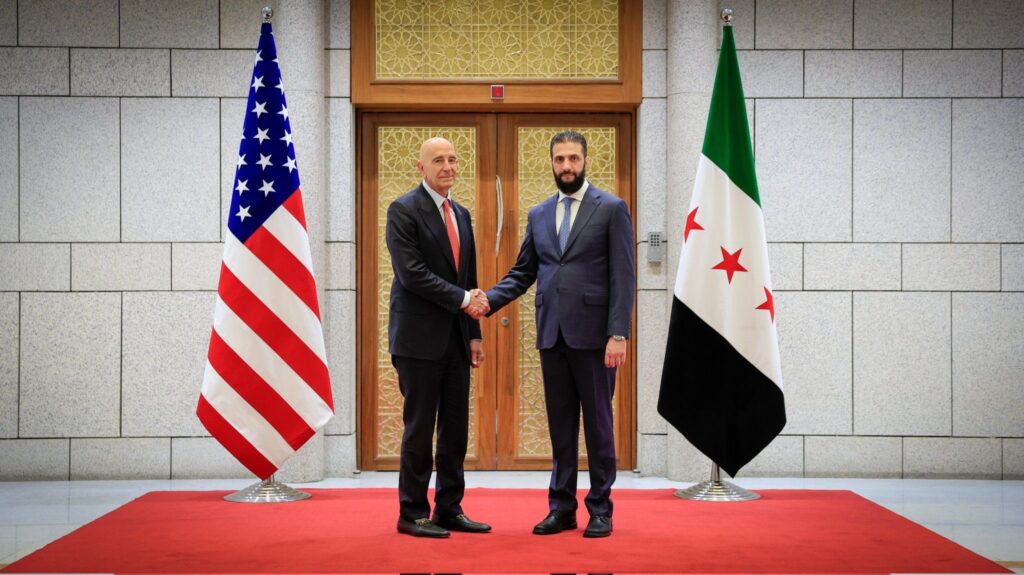
But for both Israel and the United States, achieving such outcomes requires a decision on key policy objectives in Syria. Washington, having played an important role in counterterrorism and stabilization efforts in Syria, should now consider how best to support the new government in Damascus without ceding ground to Turkish or Iranian influence. The Trump administration’s decision to lift sanctions already signaled its desire for a strategic pivot, which could be built on by encouraging its Kurdish allies and other moderate forces in Syria to join Damascus under a healthy power-sharing structure.
Israel, who has thus far managed a minority-based sectarian policy, should consider looking at Syria as a whole, and engage beyond the Druze minority in the south. Defaulting to a policy that will further encourage sectarianism may result in further “Lebanonization” of Syria. On the other hand, Israel could utilize the extensive Syria network it has built, and signal that it is willing to change the trajectory of relations between the two countries, and ally with a Damascus that is committed to the protection of minorities.
SIGN UP FOR THIS WEEK IN THE MIDEAST NEWSLETTER
This may require Israel to accept that the Syrian government may not be in position to effectively control all of its territory and hence, while Israel may hold the al-Sharaa government accountable, it should focus less on outcomes and more on the Syrian government’s intentions with respect to attacks launched from within Syria’s borders. A mechanism that allows for security dialogue and real Syrian action to prevent aggression against Israel may lead to Israel withdrawing from at least some of the areas it has seized following the overthrow of the Assad regime. Down the road, this could even lead to normalization between the countries.
Though security cooperation would have seemed a dream just a week ago, Syria’s conduct during the Israel-Iran war showed that this is a real possibility. A source close to the Syrian government stated that although the new Syrian regime doesn’t want to become involved in a war between Israel and Iran, it does not oppose Israel acting to protect itself within Syrian skies. The source also revealed that there is a level of security coordination between both countries, something unthinkable just a few months ago.
Even more recently in light of the recent Israel-Iran conflict, reports that Syria and Lebanon may join the Abraham Accords have increased. US Special Envoy to Syria Tom Barrack, said that al-Sharaa “has indicated that he doesn’t hate Israel and that he wants peace on that border.”
A spokesperson for Syria’s foreign ministry would not comment on this, although a senior official, speaking on the condition of anonymity, told Reuters that normalization efforts with Israel must be part of the 2002 Arab Peace Initiative, and not through a separate track. The official added that Syria would never give up the Golan Heights, describing it as an integral part of Syrian territory, Reuters reported.
Sa’ar claimed that Israel would never give up the Golan Heights, while also adding that Jerusalem “will welcome Syria to the peace and normalization circle in the Middle East.”
For the new Syria to succeed, the al-Sharaa government must create a new economic reality that benefits everyone. During a May visit to Aleppo, an important economic hub and the first major city to fall in the hands of the rebels, al-Sharaa declared a new kind of war. “Oh great Syrian people, the battle of construction has just begun,” he said, adding that “we do not rest and we do not relax until we rebuild Syria anew and boast about it to the entire world.”
The United States and Israel, together with the Gulf states and Europe, can assist by providing Syria with capital, technology, and knowledge. Israel could leverage its advanced technologies on water and agriculture to bolster Syria’s failing economy.
Washington’s, and its Gulf allies’, recent recognition of al-Sharaa did not happen in a vacuum, but was meant to support a future Syria that will be different from its past. The promise of power sharing, minority rights, tolerance and respect for the country’s diversity is key not only to the internal peace, but also to a possible peace between Syria and its neighbors.
This prism offers a possible constructive interdependence between al-Sharaa’s “New Syrian National Project” and Israel’s interest in its northern border. The emergence of a New Syrian National Project could only be implemented if separatists and Islamists are further pushed away from Syria’s decision-making process.
A more cohesive and responsible Syria will help the United States in its regional stabilizing attempts and will open up the possibility of Syria joining the Abraham Accords.
Itai Melchior is a nonresident senior fellow with the N7 Initiative at the Atlantic Council’s Middle East Programs. Melchior is a former diplomat, civil servant, and business leader.
Nir Boms is a Syria researcher and the co-director of the Forum for Regional Cooperation, Tel Aviv University.
Further reading
Tue, Jun 10, 2025
Why DDR programs are the missing link to Syrian stability
MENASource By
With the end of Western sanctions, Syria faces a rare opportunity to address the imbalances of the post-conflict period.
Wed, May 28, 2025
Sectarianism, social media, and Syria’s information blackhole
MENASource By
Since Assad’s December ousting, Syrians have struggled to sift the truth from fake claims about security incidents across the country.
Tue, Mar 25, 2025
Dispatch from Bekaa: Inside the sectarian skirmishes on the Syria-Lebanon border
MENASource By Nicholas Blanford
Local Shia tribesmen have battled an assortment of Sunni jihadist militias and the new Syrian security forces dominated by Hayat Tahrir al-Sham (HTS).
Image: FILE PHOTO: Syria’s interim President Ahmed al-Sharaa looks on as he attends the “Aleppo, Key to Victory” celebration marking Syria’s liberation, in Aleppo, Syria May 27, 2025. REUTERS/Khalil Ashawi/File Photo
